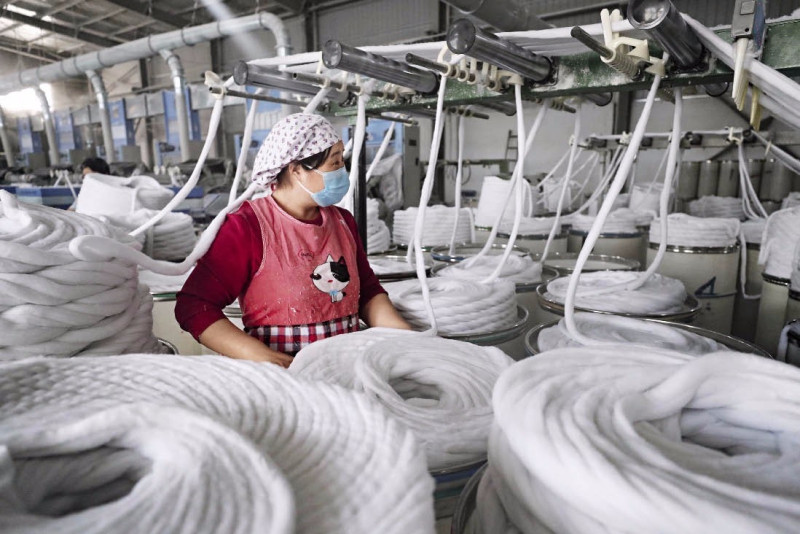
China’s Poverty Reduction in the Past 70 Years: A Major Success Worldwide
Those achievements have laid a solid foundation for eliminating absolute poverty which has plagued China for over a millennia.
As the largest developing country in the world, the People’s Republic of China (PRC) has made tremendous achievements in poverty reduction since its founding seven decades ago.
Six phases
From 1949 to 1978, China undertook poverty reduction in a broad sense under the planned economy system.
Following the founding of the PRC, the Communist Party of China led the Chinese people in carrying out socialist construction. The establishment of the socialist system and the development of the national economy provided the most basic institutional and material guarantee for fundamentally solving the problem of poverty. Through extensive infrastructure construction, the system of rural supply and marketing cooperatives and credit cooperatives was established, and a basic social security system based on the “five guarantees” (proper food, clothing, medical care, housing, and funeral expenses) and relief for the extremely poor was formed. China reduced rural poverty nationwide for the first time.
By 1978, according to the then poverty line of China, the number of poor people in rural areas had dropped to 250 million, accounting for 25.97 percent of the total poor Chinese population. The incidence of poverty in rural areas at that time was around 30.7 percent.
From 1978 to 1985, the rural economic system was reformed, which greatly further advanced poverty reduction.
A two-tier management system that was based on household contracted management and combined unified management with separate management was introduced, and supporting reforms such as raising the prices of agricultural products and developing the rural commodity economy were also implemented, greatly enhancing the productive forces in rural areas. The profound reform of the rural economic system provided a strong impetus for the extraordinary growth of China’s rural economy and the steep reduction of the poor population in this period.
In this stage, the reform of the rural land system, market system, and employment system played a major role in alleviating poverty. Through the reform of the rural land system, farmers’ market system, financial organizations supporting rural development, and the labor export system, the number of people living in absolute poverty had been greatly reduced. While bringing around a decrease in the material poverty in rural areas, the government also began to pay more attention to education in rural areas, and introduced a series of policies to improve it.
From 1986 to 1993, poverty alleviation through regional development was implemented.
During this period, the imbalance in rural regional development became prominent, and the economic, social, and cultural development of rural areas, especially that of remote and frontier areas, began to lag far behind the developed coastal areas, becoming a “policy issue requiring special treatment.” The population suffering from poverty showed obvious characteristics of regional concentration, mainly distributed in former revolutionary bases, border areas, less developed areas with large ethnic minority populations. Measures needed to be carried out in an organized, planned, and large-scale manner.
In September 1984, the CPC Central Committee and the State Council jointly issued a notice on helping impoverished areas. In April 1986, the Seventh Five-Year Plan for National Economic and Social Development of the People’s Republic of China was adopted at the fourth session of the sixth National People’s Congress, in which a separate chapter was set for the economic development of former revolutionary bases, border areas, less developed areas with large ethnic minority populations, and poverty-stricken areas. Ensuring sufficient food and clothing for the poor became a long-term goal of the Chinese government’s poverty alleviation work.
At the same time, in 1986, the Chinese government established a special poverty alleviation agency, the leading group for economic development in poor areas under the State Council, to standardize and institutionalize rural poverty alleviation and development.
From 1994 to 2000, a comprehensive poverty alleviation campaign was carried out.
This phase was marked by the issuing of a national poverty alleviation plan in March 1994 that vowed to provide 80 million more people proper food and clothing within seven years. It was made clear that each poverty-stricken village and household was to be accessed, and assistance provided in helping them create stable conditions for adequate food and clothing, develop the planting and breeding industry, and increase poverty alleviation input through multiple channels. Besides, the plan pointed out that the focus was properly allocating poverty alleviation funds, effectively implementing poverty alleviation projects, and bringing true benefits to poor townships, poor villages, and poor households.
As a result, poverty alleviation transformed from moral to institutional support, from giving the poor relief to helping them develop, and from supporting poor areas (mainly poor counties) to supporting poor villages and households.
At the same time, the central government increased poverty alleviation investment. A system was set up to make clear the roles and responsibilities of regional governments in poverty alleviation. Another system was also set up for the eastern coastal areas to support the western underdeveloped regions. In addition, various measures such as subsistence relief and ecological migration were also carried out one by one.

From 2001 to 2012, 592 counties in the central and western regions of China and 150,000 poor villages nationwide were designated as key targets for poverty alleviation. In 2007, the system of subsistence allowances was extended to rural residents. The progress in poverty alleviation has not only solved the problem of food and clothing for most poor groups, but also played a very important role in promoting sustainable and sound development of the national economy and narrowing the development gap between regions as well as between urban and rural areas.
The target for poverty alleviation has been implemented since 2013.
President Xi Jinping attaches great importance to poverty alleviation, and has put forward a series of new thoughts, arrangements, and requirements, which form China’s strategic thinking on poverty alleviation and development in the new era. Guided by Xi, China made a decision in 2015 to “win the battle against poverty,” set the goal of “lifting all the poor out of poverty by 2020 under the current standard, removing all the poor counties and solving overall regional poverty,” and implemented the strategy of targeted poverty alleviation.
A governance pattern of poverty alleviation at the provincial, municipal, county, and village levels was devised and implemented to ensure all parties involved will fulfill their responsibilities. Focus is put on six “accuracy” targets – accurate project arrangement, accurate use of funds, accurate identification of needy households, accurate dispatch of personnel to villages, and accurate results in poverty alleviation – to ensure that the policies truly benefit the poor.
Various measures have been taken to lift more people out of poverty, by developing industries and creating jobs, by relocating people to places with better natural conditions, by intensifying ecological protection, by providing better access to education, and by granting basic living allowances. All social forces are mobilized to take flexible and diverse approaches to participate in poverty alleviation. Centering on the targeted poverty alleviation strategy, innovations have been made in the mechanism of poverty alleviation and development, documentation of records of poor villages has been done, aid officials have been sent to poor villages, and a series of targeted poverty alleviation policies have been introduced. These have continuously released reform dividends for poverty alleviation. What’s more, social security has been improved; the development of a basic public service system in poor areas is accelerated; a basic old-age insurance system for urban and rural residents was established; and remarkable progress has been made in infrastructure construction in poor areas.
Achievements
China has made remarkable achievements in poverty alleviation across the country. Over the past 40 years of reform and opening-up, the income of rural residents has continued to rise, their living standards have been notably improved, and the number of poor people has dropped significantly. China’s rural areas have gone from general poverty to the overall elimination of absolute poverty. In 1978, the incidence of poverty in rural areas was about 97.5 percent, with 770 million people living in poverty. By the end of 2018, the incidence of poverty in rural areas had dropped to 1.7 percent, with 16.6 million people living in poverty. From 1978 to 2018, the number of China’s rural poor decreased by more than 700 million, and the incidence of rural poverty dropped by 95.8 percentage points.
In particular, since the 18th National Congress of the CPC, the people have been mobilized for an unprecedented campaign against poverty, which has delivered remarkable results.
First, the best poverty reduction in history was achieved. Under the current poverty line, the rural poor population dropped from 98.99 million at the end of 2012 to 16.6 million at the end of 2018; and the incidence of poverty dropped from 10.2 percent in 2012 to 1.7 percent. Second, poor areas underwent faster development. Third, the endogenous driving force of the poor people in poor areas was stimulated. Fourth, the ability of rural governance was improved. Fifth, a large number of officials and talents have been trained. Sixth, several systems for poverty alleviation have been established which provide a strong institutional guarantee. And seventh, a good social atmosphere has been created.
Those achievements have laid a solid foundation for eliminating absolute poverty which has plagued China for over a millennia. They show Chinese wisdom in addressing this problem, contribute a lot to sustainable and healthy economic development, and help China avoid falling into the middle-income trap. They also show China’s confidence in its path, theory, system, and culture with Chinese characteristics.
China’s achievements have attracted global attention. UN Secretary-General Antonio Guterres, in his congratulatory letter to the 2017 Global Poverty Reduction and Development Forum, spoke highly of China’s targeted poverty alleviation. He said that the targeted poverty reduction strategy is the only way to help the poor and achieve the ambitious goals of the 2030 Agenda for Sustainable Development. China has lifted hundreds of millions of people out of poverty, and its experience is useful for other developing countries.
Huang Chengwei is director of the National Poverty Alleviation Publicity and Education Center of the Poverty Alleviation Office of the State Council.
 Facebook
Facebook
 Twitter
Twitter
 Linkedin
Linkedin
 Google +
Google +










